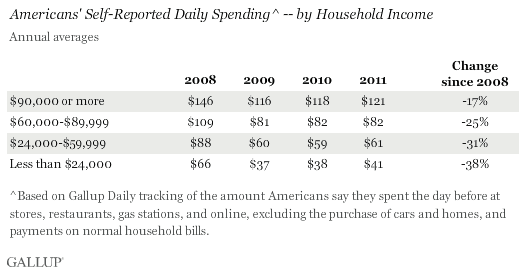PRINCETON, NJ -- Americans' self-reported daily spending averaged $76 in December, up from $71 in November and the highest monthly average of 2011. However, December's spending level is not remarkably high when compared with average spending in several other months over the past two years, including both Decembers: $75 in 2010 and $72 in 2009.

More broadly, self-reported daily spending throughout 2011, as measured in Gallup Daily tracking, averaged $67, up just slightly from $65 in 2010 and $64 in 2009. Average spending in all three years was well below the $96 of 2008, Gallup's initial measurement year. Americans' self-reported spending plummeted in January 2009 after the start of the global financial crisis in October 2008, and has not yet rebounded.
The same pattern is seen among high-income Americans and those making less than $90,000 per year. Average annual spending by each group from 2009 through 2011 was fairly flat after the much higher spending levels of 2008.

A key difference in average daily spending by income is the rate of decline between 2008 and 2011. Average daily spending among upper-income Americans was 17% lower in 2011 than in 2008. The spending of those in the three lower income groups declined by greater proportions, as much as -38% among those making less than $24,000 per year.
Bottom Line
Retailers -- and all Americans who root for a strong economy -- may have found some encouragement in the various 2011 holiday sales reports suggesting there was a strong start to the holiday shopping season after Thanksgiving, and then another surge in spending right before Christmas. A key measure of same-store sales -- computed by the International Council of Shopping Centers -- shows that 2011 holiday sales grew by 3.3% over 2010. That conforms to Gallup's November and December Christmas spending forecasts, which indicated that Americans would spend 3% to 4% more on gifts this year than last.
However, there is more to total retail sales than holiday shopping -- including routine spending on groceries, gas, furniture, clothing, appliances, electronics, and dining out. Gallup's tepid December spending figure -- little better than the December 2010 finding -- suggests that Americans may have offset some of their holiday shopping with cuts in that routine spending.
The government's retail spending report for December, due later this month, will no doubt show an increase in total retail sales over December 2010; however, some of that may be explained by two constant drivers of retail sales: inflation and population growth. After factoring those out, it's likely that real growth in December retail was fairly small.
Gallup.com reports results from these indexes in daily, weekly, and monthly averages and in Gallup.com stories. Complete trend data are always available to view and export in the following charts:
Daily: Employment, Economic Confidence and Job Creation, Consumer Spending
Weekly: Employment, Economic Confidence, Job Creation, Consumer Spending
Read more about Gallup's economic measures.
View our economic release schedule.
Survey Methods
Results are based on telephone interviews conducted as part of Gallup Daily tracking Dec. 1-29, 2011, with a random sample of 12,924 adults, aged 18 and older, living in all 50 U.S. states and the District of Columbia.
For results based on the total sample of national adults, one can say with 95% confidence that the maximum margin of sampling error is ±1 percentage point.
For results based on household income groups, one can say with 95% confidence that the maximum margin of sampling error is ±2 percentage points.
Interviews are conducted with respondents on landline telephones and cellular phones, with interviews conducted in Spanish for respondents who are primarily Spanish-speaking. Each sample includes a minimum quota of 400 cell phone respondents and 600 landline respondents per 1,000 national adults, with additional minimum quotas among landline respondents by region. Landline telephone numbers are chosen at random among listed telephone numbers. Cell phone numbers are selected using random-digit-dial methods. Landline respondents are chosen at random within each household on the basis of which member had the most recent birthday.
Samples are weighted by gender, age, race, Hispanic ethnicity, education, region, adults in the household, and phone status (cell phone only/landline only/both, cell phone mostly, and having an unlisted landline number). Demographic weighting targets are based on the March 2011 Current Population Survey figures for the aged 18 and older non-institutionalized population living in U.S. telephone households. All reported margins of sampling error include the computed design effects for weighting and sample design.
In addition to sampling error, question wording and practical difficulties in conducting surveys can introduce error or bias into the findings of public opinion polls.
For more details on Gallup's polling methodology, visit www.gallup.com.
